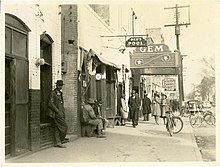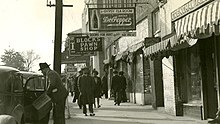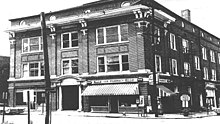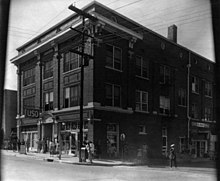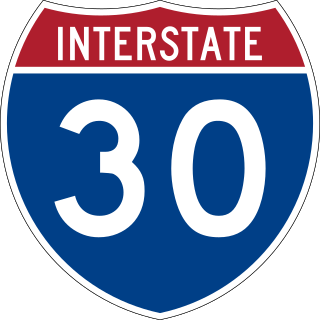
Interstate 30 (I-30) is a 366.76-mile-long (590.24 km) Interstate Highway in the southern states of Texas and Arkansas in the United States. I-30 travels from I-20 west of Fort Worth, Texas, northeast via Dallas, and Texarkana, Texas, to I-40 in North Little Rock, Arkansas. The highway parallels U.S. Highway 67 (US 67) except for the portion west of downtown Dallas. Between the termini, I-30 has interchanges with I-35W, I-35E, and I-45. I-30 is known as the Tom Landry Freeway between I-35W and I-35E, within the core of the Dallas–Fort Worth metroplex.
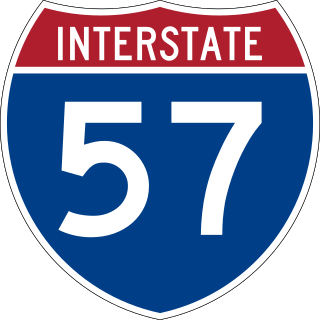
Interstate 57 (I-57) is a north–south Interstate Highway in Missouri and Illinois that parallels the old Illinois Central Railroad for much of its route. It runs from Sikeston, Missouri, at I-55 to Chicago, Illinois, at I-94. I-57 essentially serves as a shortcut route for travelers headed between the South and Chicago, bypassing St. Louis, Missouri and Springfield, Illinois. Between the junction of I-55 and I-57 in Sikeston and the junction of I-55 and I-90/I-94 in Chicago, I-55 travels for 436 miles (702 km), while the combination of I-57 and I-94 is only 396 miles (637 km) long between the same two points. In fact, both the control cities on the overhead signs and the destination mileage signs reference Memphis along southbound I-57, even as far north as its northern origin at I-94 in Chicago. Likewise, at its southern end, Chicago is the control city listed for I-57 on signs on northbound I-55 south of Sikeston, even though I-55 also goes to Chicago. A southward extension of I-57 from its current southern terminus to Little Rock, Arkansas is currently in various stages of development.

Clarksville is a city in Johnson County, Arkansas, United States. As of the 2010 census the population was 9,178, up from 7,719 in 2000. As of 2018, the estimated population was 9,743. The city is the county seat of Johnson County. It is nestled between the Arkansas River and the foothills of the Ozark Mountains, and Interstate 40 and US Highway 64 intersect within the city limits. Clarksville-Johnson County is widely known for its peaches, scenic byways and abundance of natural outdoor recreational activities.

Urban renewal is a program of land redevelopment often used to address urban decay in cities. Urban renewal involves the clearing out of blighted areas in inner cities to clear out slums and create opportunities for higher class housing, businesses, and other developments.
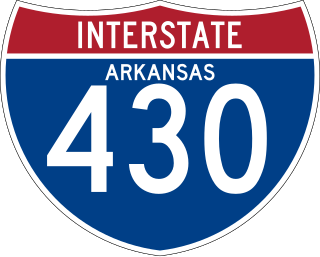
Interstate 430 (I-430) is a 12.93-mile-long (20.81 km) Interstate highway in Pulaski County, Arkansas, that bypasses the cities of Little Rock and North Little Rock. I-430 begins at an interchange southwest of Downtown Little Rock with I-30, US 67, and US 70 and travels north to cross the Arkansas River and end at I-40 and US 65. The first plans for the freeway appeared in 1955.

Interstate 630 (I-630) in Arkansas is an east–west connector within Little Rock. It is also known as the Wilbur D. Mills Freeway and starts at I-30, U.S. Highway 65 (US 65), US 67, and US 167, traveling west through downtown Little Rock to I-430 and Chenal Parkway.

Central Arkansas, also known as the Little Rock metro, designated by the United States Office of Management and Budget as the Little Rock-North Little Rock-Conway Metropolitan Statistical Area, is the most populous metro area in the U.S. state of Arkansas. With an estimated 2020 population of 748,031, it is the most populated area in Arkansas. Located at the convergence of Arkansas's other geographic regions, the region's central location make Central Arkansas an important population, economic, education, and political center in Arkansas and the South. Little Rock is the state's capital and largest city, and the city is also home to two Fortune 500 companies, Arkansas Children's Hospital, and University of Arkansas for Medical Sciences (UAMS).
The Quapaw Quarter of Little Rock, Arkansas, is a section of the city including its oldest and most historic business and residential neighborhoods. The area's name was first given in 1961, honoring the Quapaw Indians who lived in the area centuries ago.

The West End is a neighborhood of Boston, Massachusetts, bounded generally by Cambridge Street to the south, the Charles River to the west and northwest, North Washington Street on the north and northeast, and New Sudbury Street on the east. Beacon Hill is to the south, North Point is across the Charles River to the north, Kendall Square is across the Charles River to the west, and the North End is to the east. A late 1950s urban renewal project razed a large Italian and Jewish enclave and displaced over 20,000 people in order to redevelop much of the West End and part of the neighboring Downtown neighborhood. After that, the original West End became increasingly non-residential, including part of Government Center as well as much of Massachusetts General Hospital and several high rise office buildings. More recently, however, new residential buildings and spaces, as well as new parks, have been appearing across the West End.
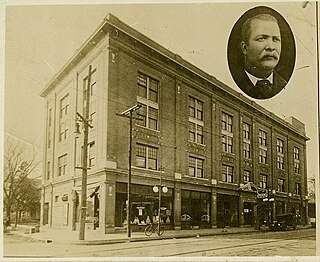
The Mosaic Templars Cultural Center is a nationally-accredited, world-class Department of Arkansas Heritage Museum and Cultural Center in Little Rock, Arkansas, United States. Its mission is to collect, preserve, interpret, and celebrate African American history, culture, and community in Arkansas from 1870 to the present and to inform and educate the public about Black achievements, especially in business, politics, and the arts.
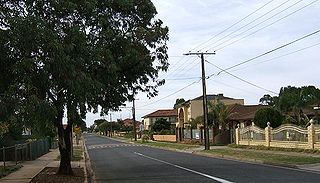
Mansfield Park is a north-western suburb of Adelaide 10 km from the CBD, in the state of South Australia, Australia and falls under the City of Port Adelaide Enfield. It is adjacent to Wingfield, Angle Park, Woodville Gardens, and Athol Park. The postcode for Mansfield Park is 5012. It is bounded to the north by Grand Junction Road, and to the west by Hanson Road. It is named after the Mansfield in East Ayrshire, Scotland.
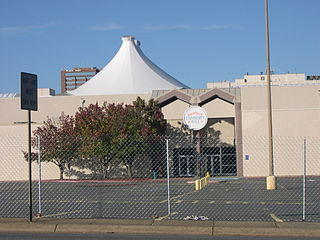
University Mall, originally The Mall, is a defunct shopping center in Little Rock, Arkansas, which operated for approximately 40 years, from 1967 until 2007. When it closed, University Mall was the oldest enclosed shopping center in the Little Rock metropolitan area. Located in the central part of Little Rock, the site is situated along South University Avenue, north of the University of Arkansas at Little Rock and Interstate 630. The mall was managed by Indianapolis-based Simon Property Group.

Capitol View/Stifft's Station is a neighborhood of Little Rock, Arkansas, in the west-central portion of the city encompassing approximately 1500 homes. Roughly, its boundaries include the area south of West Markham, north of Interstate 630, east of Pine, and west of Summit, as well as south of Riverview between Park and Summit. Capitol View/Stifft's Station is just west of Downtown, north of the Central High School Historic District, southeast of Pulaski Heights and uses the 72205 ZIP code.
Briarwood is a neighborhood in central Little Rock, Arkansas. The neighborhood includes a number of subdivisions developed during the 1950s and early 1960s. Its boundaries are West Markham Street to the north, Interstate 630 to the south, University Avenue to the east and Cunningham Lake Road to the west.

Little Rock is the capital and most populous city of the U.S. state of Arkansas. The city's population was 204,405 in 2022, according to the United States Census Bureau. As the county seat of Pulaski County, the city was incorporated on November 7, 1831, on the south bank of the Arkansas River close to the state's geographic center in Central Arkansas. The city derived its name from a rock formation along the river, named the "Little Rock" by the French explorer Jean-Baptiste Bénard de la Harpe in 1722. The capital of the Arkansas Territory was moved to Little Rock from Arkansas Post in 1821. The six-county Little Rock–North Little Rock–Conway, AR Metropolitan Statistical Area (MSA) is ranked 81st in terms of population in the United States with 748,031 residents according to the 2020 estimate by the United States Census Bureau.
Little Rock, Arkansas is home to numerous neighborhoods. See List of Little Rock Neighborhoods for an exhaustive list.
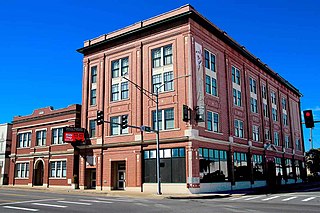
The Mosaic Templars of America was a black fraternal order founded by John E. Bush and Chester W. Keatts, two former slaves, in Little Rock, Arkansas, in 1883. The organization originally provided illness, death, and burial insurance during an era when few basic services were available to black people.

San Juan Hill was a community in what is now the Lincoln Square neighborhood of the Upper West Side in Manhattan, New York City. Its residents were mostly African-American, Afro-Caribbean, and Puerto Rican, and comprised one of the largest African-American communities in New York before World War I. San Juan Hill was bound by 59th Street to the south, West End Avenue to the west, 65th Street to the north, and Amsterdam Avenue to the east. The site is now occupied by Lincoln Center, a 16.3-acre (6.6 ha) complex dedicated to the performing arts.
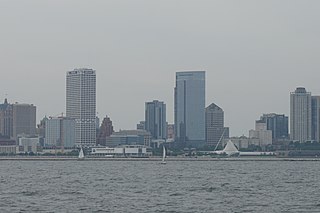
Downtown Milwaukee is the central business district of Milwaukee, Wisconsin. The economic and symbolic center of the city and the Milwaukee metropolitan area, it is Milwaukee's oldest district and home to many of region's cultural, financial educational and historical landmarks including Milwaukee City Hall, Fiserv Forum and the Milwaukee Art Museum. The city's modern history began in Downtown Milwaukee in 1795 when fur trader Jacques Vieau (1757–1852) built a post along a bluff on the east side, overlooking the Milwaukee and Menomonee rivers.
John Carter was an African-American man who was murdered in Little Rock, Arkansas, on May 4, 1927. Grabbed by a mob after another Black man had been apprehended for the alleged murder of a white girl, Carter was hanged from a telephone pole, shot, dragged through the streets, and then burned in the center of the city's Black part of town with materials that a white crowd of perhaps 5,000 people had looted from nearby stores and businesses.
